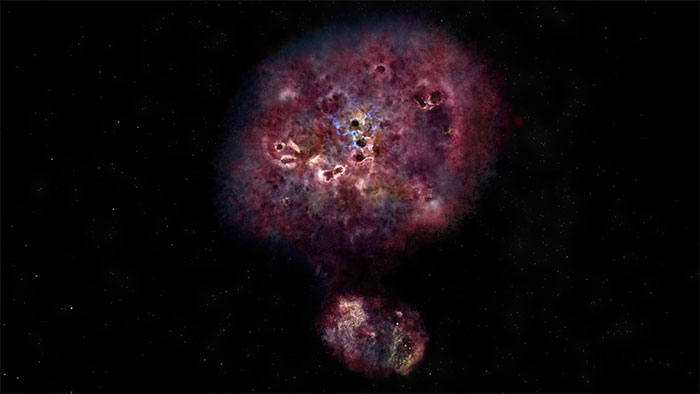The galaxy was discovered 13 billion light-years from Earth
Thanks to the ALMA telescope system in Chile, scientists observed MAMBO-9, a galaxy filled with cosmic dust and creating new stars.
MAMBO-9 is the farthest star-forming galaxy ever observed with a telescope, CNN reported on December 12. The image shows it merging with another galaxy.

Galaxy MAMBO-9 is filled with cosmic dust and produces stars at breakneck speeds.(Photo: CNN).
MAMBO-9 is considered a giant star nursery, filled with cosmic dust, the material needed to make stars. Each year, the mass of stars formed in such galaxies can be several thousand times that of the Sun. Meanwhile, the number of new stars in the Milky Way galaxy is only three times per year.
What's amazing is that MAMBO-9 appeared just after the Big Bang about 900 million years , in the early universe. Previously, astronomers did not think it would be possible to find such giant giant galactic nurseries. However, the discovery of MAMBO-9 and other distant galaxies changed this thinking. By creating vast amounts of new stars, they can affect the universe, helping it evolve.
However, the dust and the remote distances of stellar production factories make it difficult for scientists to observe. "These galaxies are often hidden from human sight. We know they are out there, but they are not easily detected because the light from them is obscured by clouds , " said Caitlin Casey, lead author of the study. at Texas University, said.
10 years ago, scientist Manuel Aravena at the University of Diego Portales, first discovered light from MAMBO-9. However, she and her colleagues have not been able to gather enough information to understand its distance and age. The ALMA telescope system is sensitive enough to detect such distant and cosmic galaxies. However, the biggest obstacle in the search process is the other galaxies. Galaxies near Earth will obscure light from distant "friends".
"The mass of gas and dust in MAMBO-9 is extremely large, 10 times the total mass of the Milky Way galaxy. This means it has not yet produced most of its star," Casey said. The team hopes the data from ALMA will help them discover more distant galaxies filled with cosmic dust, thereby grasping the number and why they formed so early.
Cosmic dust in MAMBO-9 is also a mystery that scientists want to learn more."Dust is usually a byproduct of dying stars. We expect stars to be 100 times more massive than dust, but MAMBO-9 has not yet produced so many stars. We also want to know why dust is rapidly forming." like that after the Big Bang, " said Casey.
- EGSY8p7 Detection - The oldest galaxy ever found
- The galaxy is 13.28 billion light-years from Earth
- Discovered 'evil galaxy' transparent like illusion
- Discover the most distant galaxy group
- Discover the oldest galaxy in the universe
- The early galaxy cluster is 12.4 billion light-years away from Earth
- Star 'starving' black hole is a billion light years from Earth
- Expose the brightest galaxy ever
- Unprecedented discovery of supernovae
- Discover the greatest 'star factory' in the universe
- The galaxy glows brightly when it produces 4,500 times more stars than the Milky Way
- The pair of black superholes is 400 million light years from Earth
 Van Allen's belt and evidence that the Apollo 11 mission to the Moon was myth
Van Allen's belt and evidence that the Apollo 11 mission to the Moon was myth The levels of civilization in the universe (Kardashev scale)
The levels of civilization in the universe (Kardashev scale) Today Mars, the sun and the Earth are aligned
Today Mars, the sun and the Earth are aligned The Amazon owner announced a secret plan to build a space base for thousands of people
The Amazon owner announced a secret plan to build a space base for thousands of people